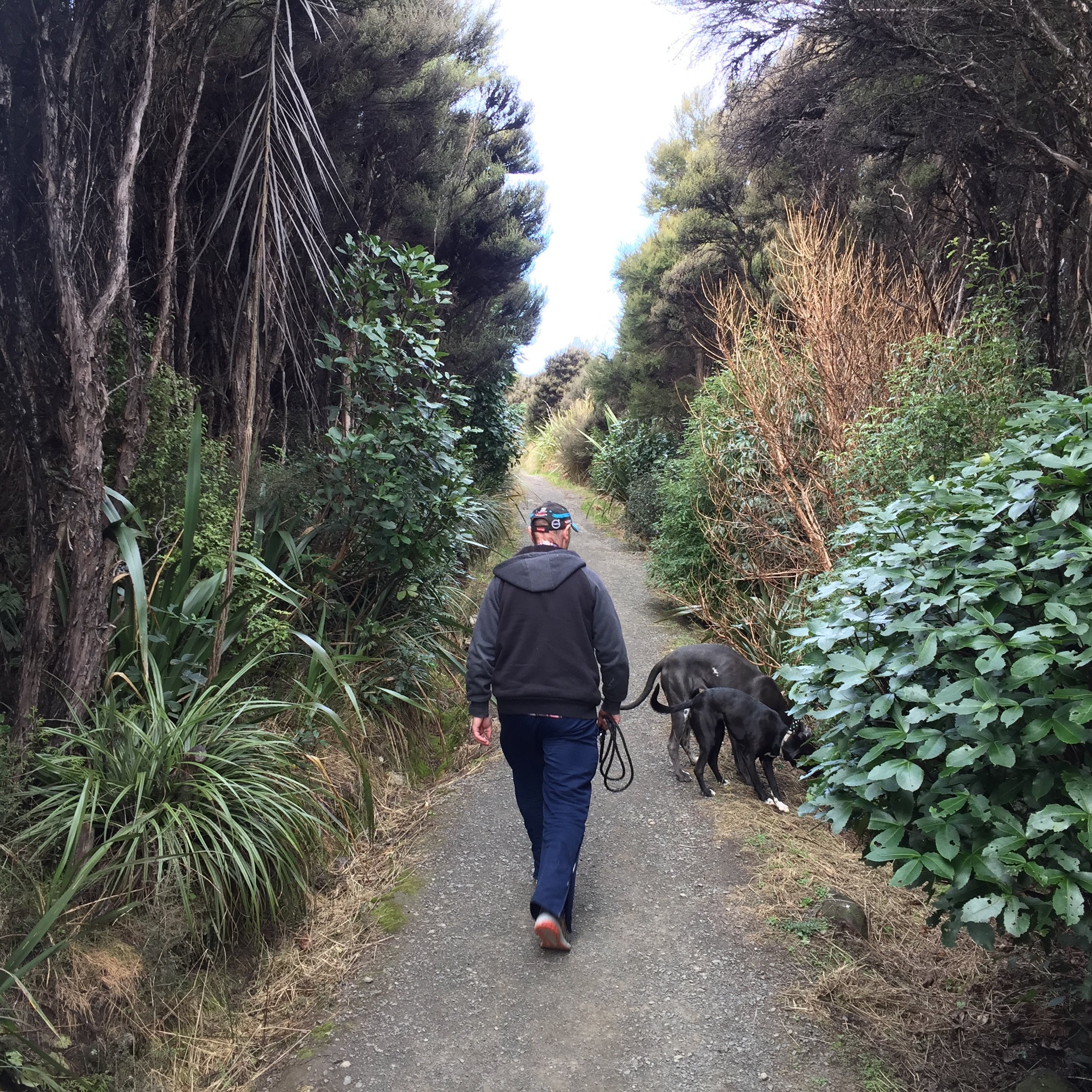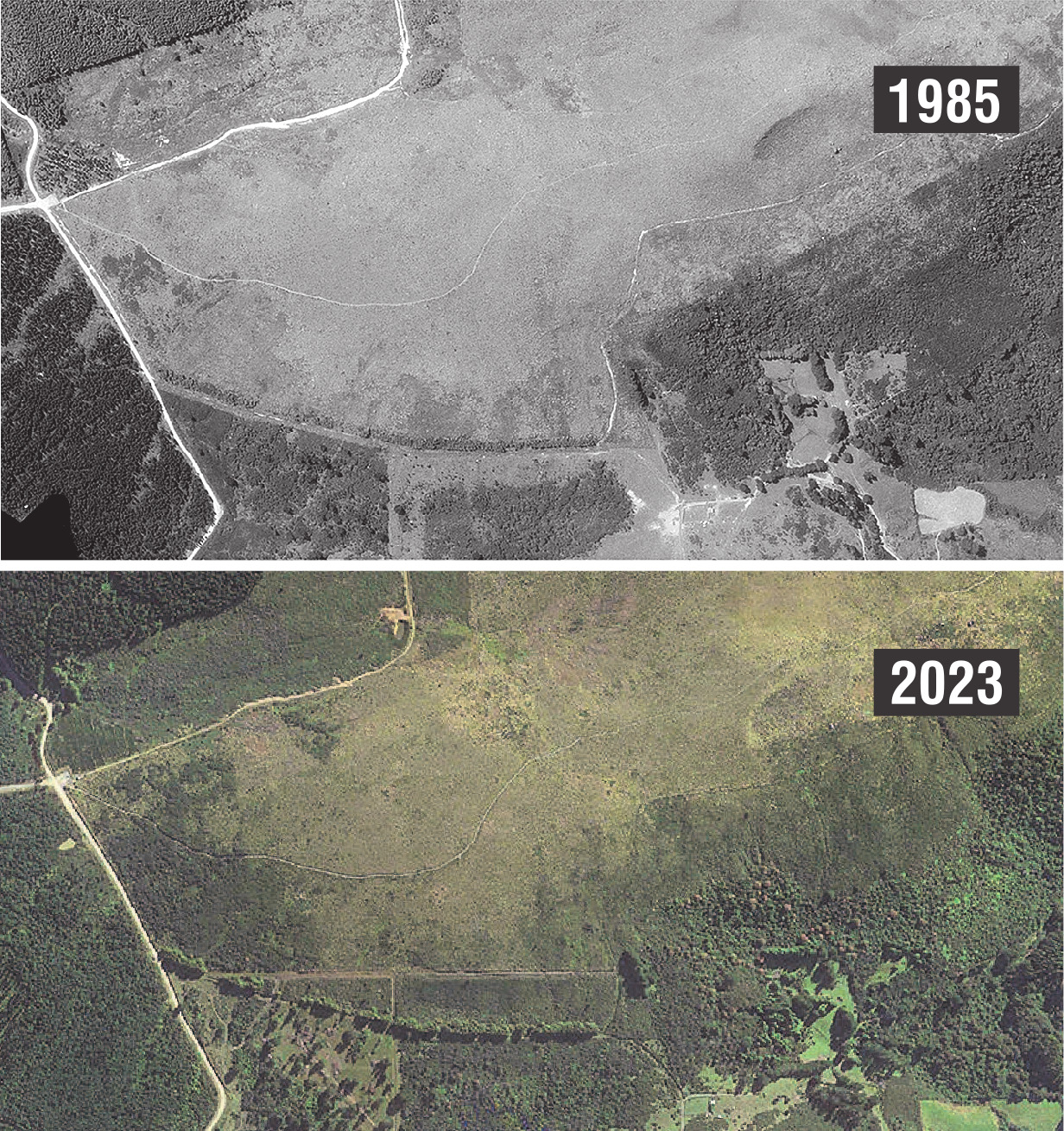
Most days dozens of walkers and runners enjoy the snow tussock grassland of Dunedin’s Flagstaff Scenic Reserve, with views to the distant Rock and Pillar range west of Middlemarch, across the Taieri Plain to the south, and over the ocean to the east.
But these vistas are under threat of being blocked out as the alpine-like landscape slowly regenerates back into native bush.
An aerial photograph from 1985 shows an almost complete absence of native trees on the upper slopes. This contrasts with today, where walkers setting out from the Bullring carpark on Whare Flat Rd encounter tall mānuka and kānuka trees dominating much of the first half kilometre of the track. Only higher up do views across Dunedin become possible, and even here, more native trees are sprouting up among the tussock as the bush continues its slow but steady advance up the hill.
Looking into the future, kererū and other birds may perch on the kānuka tree boughs, depositing seeds of totara and rimu berries, potentially turning the area to a native forest similar to the upper south-east slopes of neighbouring Mt Cargill.
Assoc Prof Janice Lord, of the University of Otago botany department, says the regeneration of native trees isn’t unexpected, because Flagstaff wasn’t always the alpine-like grassland of today. A study of centuries-old logs found in the area shows the ridge was once semi-wooded with mountain totara, native cedars, pink pine and possibly some silver beech.
"It wouldn’t have been tall dense forest like you get lower down, it would have been a bit more wind-blown and open," she says.
Small patches of snow tussock were always part of the natural landscape, but they became a dominant species after burning by early Māori.
"There would have been some tussock there before humans, it’s just spread out following fires," she says.
Sir Alan Mark, emeritus professor of botany at the University of Otago, has suggested the flames that several hundred years ago encouraged Flagstaff’s tussock to flourish, could be utilised again in the form of managed fires, to keep the advancing native trees at bay.
Now 91, Sir Alan’s academic career has included a lifetime of studies on snow tussock, and over the years he’s fought to keep Flagstaff’s sweeping 360-degree panorama free of trees.
His first challenge was after the Dunedin City Council had designated the hill as a future pine plantation.
"When I was at the botany department, doing my master’s on snow tussock in the 1950s, I could see the value of preserving the tussock on Flagstaff as part of Dunedin’s skyline, rather than having it planted in Pinus radiata."
In the early 1970s he served on a team of technical advisers to the DCC, and recommended the city council make Flagstaff a scenic reserve.
"I was determined to do what I could to prevent a pine plantation on the top of Flagstaff - the skyline was much too important and the snow tussock at such low elevation was of interest."
Sir Alan hopes the grassland can remain as a study environment for future botany students, especially as snow tussock is remarkable for its longevity, describing the plant as "potentially immortal".
"They just go on - as one tiller dies after flowering, it always produces three or four new ones at the base and they take over and it takes about 15 years before they are ripe to respond to a warm summer and flower.
"So the whole thing turns over slowly - I can’t see any reason for them dying."

"Once you’ve got a few snow tussocks in an area and it gets burned, the snow tussocks recover and seeds blow in the wind and germinate in the first summer after the fire."
Many decades ago, Sir Alan started suggesting the DCC could deliberately burn off regenerating areas on Flagstaff.
"I did recommend to the city that they might consider managed fires to maintain the tussock grassland, because it was obvious that mānuka and kānuka were coming up from the Bullring area and making their way towards the summit," he says.
"Rather than in the late summer or autumn, they could have burned it in the early spring, when fire does much less damage to the grassland.
"But the city wasn’t interested."
In September 2019, a fire did attack the landscape with an uncontrolled blaze sweeping across 30ha of tussock and shrubs on the north-eastern side of Flagstaff, near the top of the Pineapple Track.
Sir Alan says the fire came after a dry spell and was much harsher on the tussock than the occasional early spring fires he had been advocating.
Broom and gorse, which have been an issue in the area for decades, sprouted up in huge numbers among the ashes.
In April 2022, three years after the fire, the DCC employed a helicopter to spray this flourishing crop of weeds with a herbicide selective enough to leave the tussock and flax largely unaffected. The former burned area is now a collection of dead sticks gradually rotting away while an understory of tussock and flax comes though.
Sir Alan concedes if the DCC were to change tack and follow his suggestion of using fire to maintain the tussock, an inevitable fresh crop of broom and gorse may need to be sprayed after the fire.
"A helicopter is so indiscriminate, it will take things like native orchids. Hand spraying would be preferable, taking out the offending bushes and leaving the rest of it untouched."
While today most hikers don’t notice the slow march of native trees gradually taking over from the tussock on Flagstaff, Prof Lord agrees it will eventually become an issue to be addressed.
"This is a conversation the DCC needs to have with the community.
"People quite like the tussock because they can see the view, but if you let it do its thing, it’s going to become more and more forested."

What’s in a name?
• Mt Kettle was the original name early European settlers used for Flagstaff, after the surveyor Charles Kettle. The name changed to Mt Flagstaff and eventually simply Flagstaff, after the flag the surveyors flew on the summit of what was their first trigonometry station.
• While these days the Māori name for Flagstaff is Te Whanaupaki, it was originally called Whakari - a name that still survives, albeit in corrupted form, for the nearby suburb of Wakari.
• Matanaka - Johnny Jones’ settlement near Waikouaiti - is another corruption, taken from a nearby beach called Mata-Inanga, referring to whitebait in the area.
• The Bullring carpark, built in the 1970s by the Forest Service, is not named after the mid-19th century bullock trail from Matanaka. It is actually named such because the carpark’s fence - constructed with railway irons - made the carpark look like a bullring.










